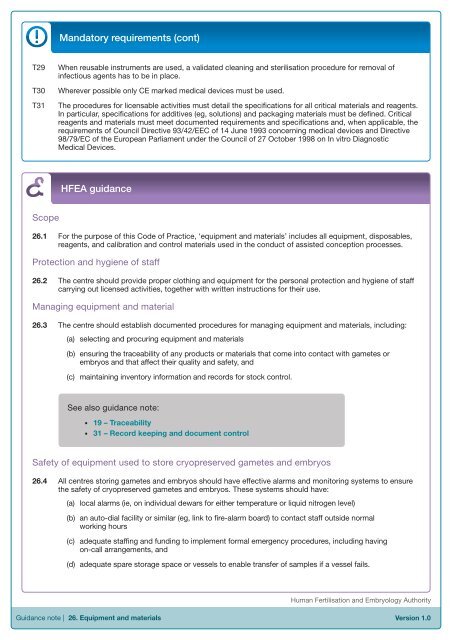Eighth Edition - R.3 - Human Fertilisation & Embryology Authority
Eighth Edition - R.3 - Human Fertilisation & Embryology Authority
Eighth Edition - R.3 - Human Fertilisation & Embryology Authority
You also want an ePaper? Increase the reach of your titles
YUMPU automatically turns print PDFs into web optimized ePapers that Google loves.
Mandatory requirements (cont)<br />
T29<br />
T30<br />
T31<br />
When reusable instruments are used, a validated cleaning and sterilisation procedure for removal of<br />
infectious agents has to be in place.<br />
Wherever possible only CE marked medical devices must be used.<br />
The procedures for licensable activities must detail the specifications for all critical materials and reagents.<br />
In particular, specifications for additives (eg, solutions) and packaging materials must be defined. Critical<br />
reagents and materials must meet documented requirements and specifications and, when applicable, the<br />
requirements of Council Directive 93/42/EEC of 14 June 1993 concerning medical devices and Directive<br />
98/79/EC of the European Parliament under the Council of 27 October 1998 on In vitro Diagnostic<br />
Medical Devices.<br />
HFEA guidance<br />
Scope<br />
26.1 For the purpose of this Code of Practice, ‘equipment and materials’ includes all equipment, disposables,<br />
reagents, and calibration and control materials used in the conduct of assisted conception processes.<br />
Protection and hygiene of staff<br />
26.2 The centre should provide proper clothing and equipment for the personal protection and hygiene of staff<br />
carrying out licensed activities, together with written instructions for their use.<br />
Managing equipment and material<br />
26.3 The centre should establish documented procedures for managing equipment and materials, including:<br />
(a)<br />
selecting and procuring equipment and materials<br />
(b)<br />
(c)<br />
ensuring the traceability of any products or materials that come into contact with gametes or<br />
embryos and that affect their quality and safety, and<br />
maintaining inventory information and records for stock control.<br />
See also guidance note:<br />
19 – Traceability<br />
31 – Record keeping and document control<br />
Safety of equipment used to store cryopreserved gametes and embryos<br />
26.4 All centres storing gametes and embryos should have effective alarms and monitoring systems to ensure<br />
the safety of cryopreserved gametes and embryos. These systems should have:<br />
(a)<br />
local alarms (ie, on individual dewars for either temperature or liquid nitrogen level)<br />
(b)<br />
(c)<br />
(d)<br />
an auto-dial facility or similar (eg, link to fire-alarm board) to contact staff outside normal<br />
working hours<br />
adequate staffing and funding to implement formal emergency procedures, including having<br />
on-call arrangements, and<br />
adequate spare storage space or vessels to enable transfer of samples if a vessel fails.<br />
<strong>Human</strong> <strong>Fertilisation</strong> and <strong>Embryology</strong> <strong>Authority</strong><br />
Guidance note | 26. Equipment and materials<br />
Version 1.0

















